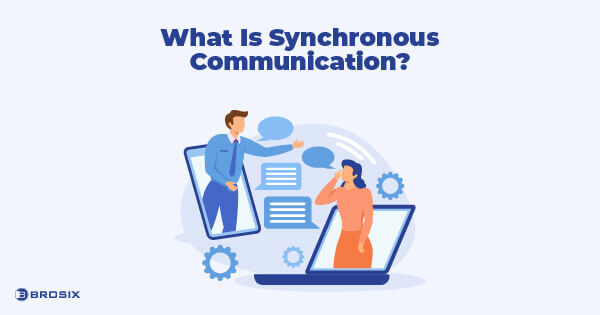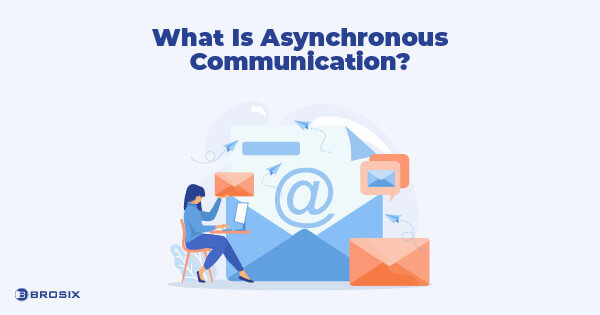The main difference between synchronous and asynchronous communication is that synchronous communication is a scheduled real-time conversation in person, by video or phone, requiring an immediate response. On the other hand, asynchronous communication happens over a more extended period as no one expects an instant reply, letting everyone respond at their own pace.
A staggering 96% of people surveyed in a Project.co study said businesses they deal with could improve their communication. Communication challenges aren’t really new, but the pandemic and massive switch to remote work have only broadened these issues.
These new circumstances have forced hybrid and remote teams to rethink their current approaches and look for ways to communicate to benefit all team members.
Here, we’ll take a deep dive into what constitutes synchronous and asynchronous communication, how they differ, and which one you should be using more.
The Difference Between Synchronous and Asynchronous Communications
Companies stand to lose a lot as a result of poorly managed communication between employees. A survey conducted among businesses with 100 employees or more revealed these companies lose $420,000 per year due to miscommunication.
Hence, it could be fruitful to learn about the differences between synchronous and asynchronous communication, as this will help you to use them both in the most productive way possible.
Let’s explore what these two different types of communication bring to the table.
What Is Synchronous Communication?
Synchronous communication is usually the default in any workplace. Whenever you need a question answered or a document sent right away, you’ll turn to synchronous communication. Work processes would be infinitely less productive without it. Imagine having to wait hours or even days to get a simple “yes/no” answer, get the nod for an important decision or receive a work file.
As we mentioned in the introduction, synchronous communication involves real-time communication between two or more people, where the parties involved participate simultaneously. These are some of the key aspects of synchronous communication methods:
- Takes place in real time
- Communication is instantaneous
- Responses are expected immediately
Examples of Synchronous Communication
The most common forms of synchronous communication are:
- Face-to-face conversation in the office
- Team meetings
- One-on-one meetings
- Phone calls
- Video calls
- SMS text messaging
- Instant messaging through Slack and other collaboration platforms
Synchronous communication is not limited to any particular medium. It involves both online and offline communication. A colleague walking into your office with a question or convening an in-person meeting is probably the oldest and most traditional form of sync communication. However, sending Microsoft Teams or Slack messages or audio and video calls all fall into the same category.
As long as a conversation where the other party is expected to answer immediately occurs, be it in-person or between remote workers, online or SMS, it’s considered synchronous.
Before we delve deeper into the pros and cons of sync communication, let’s see what constitutes asynchronous communication first.
What Is Asynchronous Communication?
The easiest way to understand asynchronous communication is to think about it as any form of exchange where no one expects you to respond immediately. You react in your time frame, and everyone expects a specific lag time between messages.
One of the oldest and most trusted forms of asynchronous communication is the good old email. Email is the gold standard for professional, remote communication and is usually used as a prime example of async communication.
When you send out an email, no one is expected to answer immediately, nor do you have any way of knowing whether the person on the receiving end was online or read the email. As such, async communications happen over a more extended time, unlike synchronous communication, which is instant.
Furthermore, asynchronous communication is usually not planned or scheduled, as it doesn’t require all correspondents to be available simultaneously.
The primary characteristics of asynchronous communication are:
- Does not take place in real time
- Immediate response is not expected
- Asynchronous communications are not scheduled
- Happens over some time
Examples of Asynchronous Communication
Here are the most used forms of asynchronous communication:
- Traditional mail
- Text messaging via phone (SMS, MMS)
- Instant messaging through various collaboration and messaging apps (Slack, Teams, Telegram, WhatsApp)
- Audio messages
- Video messages
- Project management tools (Notion, Asana)
- Company workspace or intranet
Emails are far from being the only method that belongs to this category – there are many other asynchronous communication tools at your disposal. Communication through project management tools, sending video or voice messages, and communication through company wikis and workspaces are all considered asynchronous forms of communication.
You’ll see that some communication mediums appear both in synchronous and asynchronous lists. This, naturally, might come as a surprise – after all, how can something be both synchronous and asynchronous at the same time?
The answer is context. For example, messaging a teammate working in the same shift/time zone on Slack or Microsoft Teams is considered synchronous. This is because that team member is expected to be online and available at the time, and it’s supposed to be practically the same as if you hopped over to their desk.
On the other hand, if the person you’re reaching out to is working remotely and in a different time zone, no one expects them to get up at 3 AM and answer your query. Hence, the same communication method would be considered asynchronous in this situation.
Now that we’ve covered what asynchronous and synchronous communication includes, it’s time to take a look at the advantages and disadvantages of each.
Best Practices for Synchronous Communication Within Remote Teams
Using synchronous communication to exchange information between remote colleagues in real time can easily happen by scheduling a live meeting. To achieve more productive results, consider following these best practices:
- Restrict the number of attendees to ensure a focused and productive discussion.
- Consider recording the call or meeting for future reference or for those who couldn’t attend.
- Stick to an agenda to keep the meeting on track and cover all necessary topics.
- Take the time to familiarize yourself with the features of the communication platform you’re using to make the most of its capabilities.
- After the meeting, send follow-up communication to summarize the key points discussed and any action items assigned.
Pros and Cons of Synchronous Communication
Getting remote employees spread around different time zones and locations on the same page requires careful planning and organization. Let’s see how using synchronous interaction can help or disturb the communication process.
Pros of synchronous communication
Thanks to its characteristics, synchronous communication is excellent for:
- Getting quick answers
- Brainstorming ideas and having constructive discussions
- To discuss sensitive topics or personal matters
- Fostering engagement between team members
- Providing feedback
- Building rapport
- Quickly solving problems
Synchronous communication serves us best in rapidly-changing circumstances or when time is of the essence.
When working at the office, talking to someone a desk away or popping over to their cubicle is quick, painless, and direct. You can instantly share any information needed, get answers, iron out any problems and handle follow-up questions. If you were forced to wait hours to get simple, short answers or status updates, any severe project would take years to complete.
Additionally, any project or task that warrants live, quick status updates requires instant communication. For example, if you’ve just pushed out a new software update or launched a service, your team will need to tackle problems as they come, which makes for a hectic and dynamic environment.
Asynchronous communication won’t be appropriate here, as circumstances can change dramatically in the time it takes for other team members to respond.
In-person synchronous communication was one of the first victims when the pandemic hit, placing difficult logistical obstacles in front of all of us. Thankfully, we quickly adapted and switched to various online tools and platforms for instant communication.
Synchronous communication is best when you need information immediately. It lets team members rapidly reach agreements and gets everyone on the same page quickly. Furthermore, thanks to the speed and flexibility of synchronous communication, it’s ideal for brainstorming new ideas. Imagine having a whole department try to pitch and discuss ideas over email – a recipe for disaster.
The original purpose of Slack and other collaboration software was to cut down on the needless and incessant emailing and let employees quickly reach across the board and get things done.
Synchronous communication methods are also much better for providing direct, instant feedback or building a rapport with team members or subordinates. While email might be better for longer, detailed reports, tools like instant messaging are better for giving “the nod” on things like social media posts, graphic design decisions, and so forth.
Asynchronous communication is often somewhat rigid in form, and because of the lack of real-time communication, it’s often less appropriate for situations like these.
Lastly, the major benefit of synchronous communications is instantly getting on top of any crisis or problems that may arise. If you’re in the middle of a PR nightmare, you need everyone to get on the same page immediately and agree upon a strategy – not wait several hours for everyone to read the email.
Cons of synchronous communication
Drawbacks of synchronous communication:
- Not adaptable for teams in multiple time zones
- Often time-consuming
- Can disrupt focus
- Dependant on everyone having a stable connection (for digital meetings)
While synchronous communication is something we tend to turn to instinctively, it’s not always the correct route to take. As we discussed before, synchronous communication alone isn’t enough for a fully remote team spread across different time zones.
As synchronous communication requires everyone to be present simultaneously, either in-person or digitally, it can be challenging to organize given the time differences. If time differences are more extreme, it’s almost certain that someone will have to be up at odd hours to attend the meeting or answer any questions.
Some forms of synchronous communication, such as meetings, can last forever. Something that could’ve been relayed through email gets turned into a meeting, which in turn transforms into a multi-hour ordeal. No wonder “this could’ve been an email” is a famous saying in the corporate world.
Lastly, contacting someone through instant messaging can break the other person’s concentration and reduce their productivity. Everyone has probably been driven crazy by the unrelenting notification sounds of messages pouring in while you’re trying to focus on the task at hand. Once you lose focus, it can take you hours to get back on track. As such, using less aggressive and focus-breaking methods of communication is often a better solution.
Best Practices for Asynchronous Communication for Remote Teams
Using asynchronous communication forms that don’t require an immediate reply, such as email and project management platforms, enables smooth connection even with time zone differences.
To make it even smoother, these best practices can help:
- Assess how you allocate your time and identify areas where asynchronous communication can be effectively utilized instead of relying solely on synchronous methods.
- Establish clear and realistic deadlines for tasks and deliverables—this ensures that everyone is on the same page and can plan their work accordingly.
- Clearly express your requirements, instructions, or requests when communicating asynchronously to convey your expectations in the best way possible and to avoid any misinterpretation.
- Respond with detailed information and use comprehensive statements to address questions or concerns. This saves you from unnecessary back-and-forth exchanges and facilitates a more efficient conversation.
- Know when to schedule a meeting in situations where a synchronous conversation is more appropriate. Recognize when complex topics require real-time interaction.
Pros and Cons of Asynchronous Communication
Now that remote work has become common, it’s going to stay around. That’s why determining the advantages and disadvantages of the asynchronous communication style is important.
Pros of asynchronous communication
The main benefits of asynchronous communication are:
- Multi time-zone friendliness
- No scheduling
- Less pressure
- Not dependant on internet connection strength
- Gives time for thought out, quality responses
As you might’ve guessed, asynchronous communication shines where synchronous communication falters. First of all, there’s practically no planning or scheduling involved with asynchronous communication. There is no need to plan meetings ahead of time, juggling possible meeting times and trying to fit them into everyone’s schedule. You send an email or leave a message on the company intranet, and the recipient will see and respond when they have the time.
Secondly, involved parties can respond at their own pace without the need and expectation of real-time responses. This has multiple benefits. First, it helps you work uninterrupted and answer when you have the time. Second, it lets you think the answer through and send a better and more considered response.
Additionally, asynchronous communication takes off a lot of stress of intra-business communication, where being constantly online and available is often a requirement. This is generally a problem with modern-day instant communication. We’re all expected to be always online and available.
On top of that, many apps let the other person know when you’ve read their message, adding even more pressure. Without this sort of pressure, everyone is happier, more relaxed, and therefore more productive.
Furthermore, asynchronous communication is not dependent on someone’s internet connection strength or the hardware they have access to. You can always come back to writing an email or leaving a post on the company intranet, even if your PC crashes.
Lastly, asynchronous communication is very multi time-zone friendly. Since it doesn’t require team members to be present, people with entirely different working hours can communicate asynchronously. In a time when remote working is the norm, this is an invaluable asset.
Cons of asynchronous communication
Here are the major disadvantages of asynchronous communications:
- Can be slow
- Insufficient for solving problems immediately
- Requires messages to be more carefully written, extensive and detailed
Of course, asynchronous communication is not without its drawbacks. The main one is, obviously, speed. Communicating asynchronously just doesn’t cut it when you need answers, feedback, or help quickly.
Most asynchronous communication methods lack that sense of immediacy and emergency. While this helps alleviate pressure, it’s also a significant stumbling block in times of need. Whenever a crisis arises, and you need to solve or resolve something quickly, asynchronous communication will be too slow.
Additionally, asynchronous communication requires involved parties to send longer and detailed messages. You need to explain everything within a single message to prevent a prolonged back-and-forth. Hence, this can also become time-consuming, as you’ll need to word your email carefully to remove any potential for misinterpretation. If you’ve ever sent official emails, you’ve probably spent time and energy making sure the message doesn’t accidentally come off as rude or pompous.
Final Thoughts
In an ever-changing world where technological advances and unexpected circumstances like the pandemic thoroughly change how we work, optimizing our communication is vital.
Hopefully, we’ve managed to help you better understand the synchronous vs. asynchronous communication debate and assist you in improving your company’s communication and collaboration processes.
In case you’re finding it hard to balance different communication mediums with the tools you currently have, give Brosix’s platform a spin and bring your intra-company communication to the next level.











